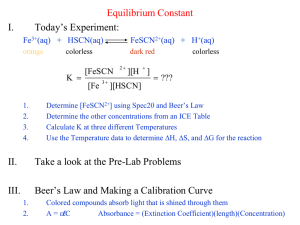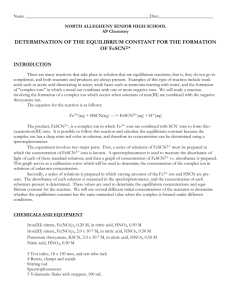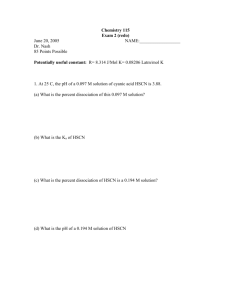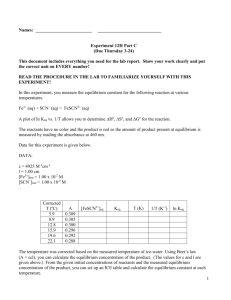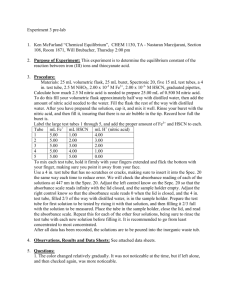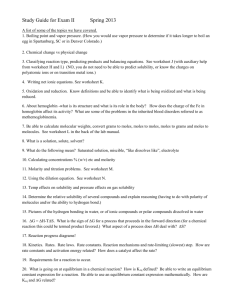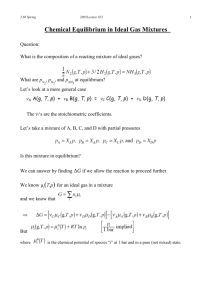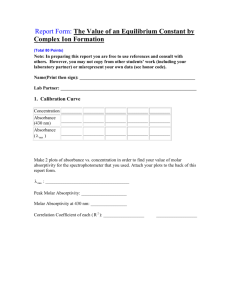Equilibrium Constant Determination INTRODUCTION Every
advertisement
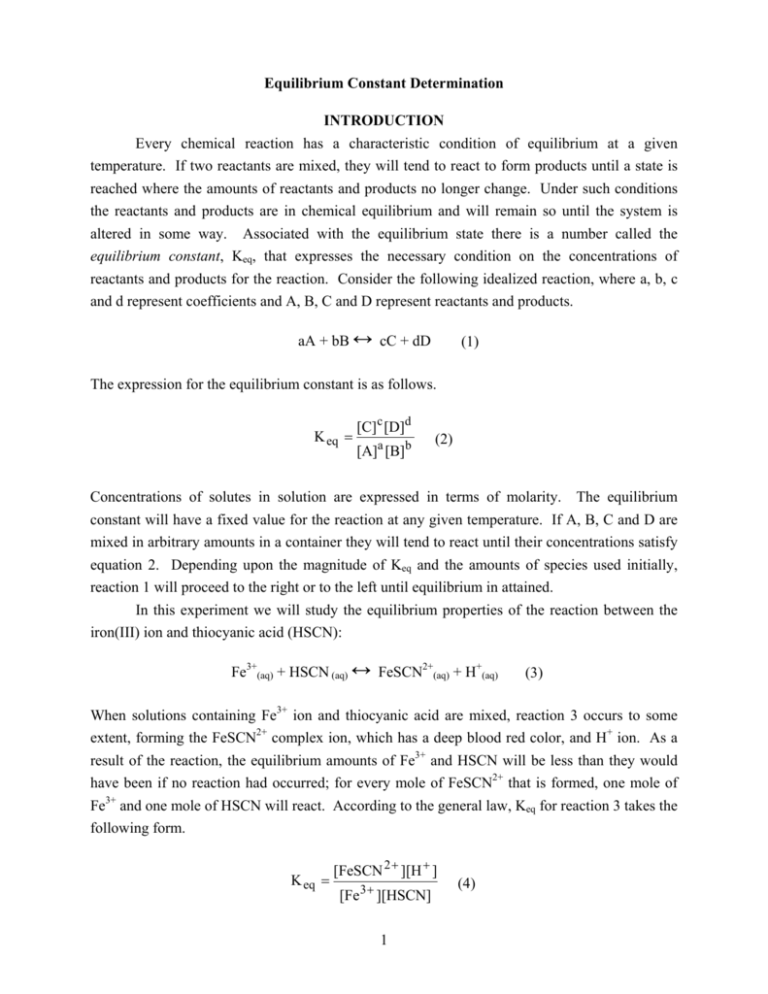
Equilibrium Constant Determination INTRODUCTION Every chemical reaction has a characteristic condition of equilibrium at a given temperature. If two reactants are mixed, they will tend to react to form products until a state is reached where the amounts of reactants and products no longer change. Under such conditions the reactants and products are in chemical equilibrium and will remain so until the system is altered in some way. Associated with the equilibrium state there is a number called the equilibrium constant, Keq, that expresses the necessary condition on the concentrations of reactants and products for the reaction. Consider the following idealized reaction, where a, b, c and d represent coefficients and A, B, C and D represent reactants and products. aA + bB ¥ cC + dD (1) The expression for the equilibrium constant is as follows. K eq = [C]c [D]d [A]a [B]b (2) Concentrations of solutes in solution are expressed in terms of molarity. The equilibrium constant will have a fixed value for the reaction at any given temperature. If A, B, C and D are mixed in arbitrary amounts in a container they will tend to react until their concentrations satisfy equation 2. Depending upon the magnitude of Keq and the amounts of species used initially, reaction 1 will proceed to the right or to the left until equilibrium in attained. In this experiment we will study the equilibrium properties of the reaction between the iron(III) ion and thiocyanic acid (HSCN): Fe3+(aq) + HSCN (aq) ¥ FeSCN2+(aq) + H+(aq) (3) When solutions containing Fe3+ ion and thiocyanic acid are mixed, reaction 3 occurs to some extent, forming the FeSCN2+ complex ion, which has a deep blood red color, and H+ ion. As a result of the reaction, the equilibrium amounts of Fe3+ and HSCN will be less than they would have been if no reaction had occurred; for every mole of FeSCN2+ that is formed, one mole of Fe3+ and one mole of HSCN will react. According to the general law, Keq for reaction 3 takes the following form. K eq = [FeSCN 2 + ][H + ] [Fe 3 + ][HSCN] 1 (4) Our purpose in the experiment will be to evaluate Keq for the reaction by determining the equilibrium concentrations of the four species in equation 4 in several solutions made up in different ways. The equilibrium constant for the reaction has a convenient magnitude and the color of the FeSCN2+ ion makes for an easy analysis of the equilibrium mixture. The solutions will be prepared by mixing solutions containing known concentrations of iron(III) nitrate and thiocyanic acid. The color of the FeSCN2+ ion formed will allow us to determine its equilibrium concentration by spectroscopy. Knowing the initial composition of the solution and the equilibrium concentration of FeSCN2+, we can calculate the equilibrium concentrations of the rest of the pertinent species and then calculate Keq. Since the calculations that are necessary to find Keq may not be apparent, let us consider a specific example. Assume that we prepare our solution by mixing 10.0 mL of 2.00 x 10-3 M Fe(NO3)3 with 10.0 mL of 2.00 x 10-3 M HSCN under conditions which keep [H+] equal to 0.500 M. The Fe3+ in the iron(III) nitrate reacts with the HSCN to produce some red FeSCN2+ complex ion. By spectroscopy and Beer’s Law, it is found that [FeSCN2+] at equilibrium is 1.50 x 10-4 M. To find Keq for the reaction from these data, it is convenient first to determine how many moles of reactant species were initially present before a reaction occurred. By the definition of the molarity of a species A, MA = moles A or moles A = MAV Liters A where V is the volume of the solution in liters. (Remember that 1000 mL = 1 L.) initial moles Fe3+ = (MFe3+)(VFe3+) = 2.00 x 10-3 mol/L (0.0100 L) = 2.00 x 10-5 mol Fe3+ initial moles HSCN = (MHSCN)(VHSCN) = 2.00 x 10-3 mol/L (0.0100 L) = 2.00 x 10-5 mol HSCN The number of moles of FeSCN2+ present at equilibrium is found from the molarity and the volume of the solution (10.0 mL + 10.0 mL = 20.0 mL). equilibrium moles FeSCN2+ = (MFeSCN2+)(VFeSCN2+) = 1.50 x 10-4 M (0.0200 L) = 3.00 x 10-6 mol FeSCN2+ The FeSCN2+ ion is produced as shown in equation 3. 2 Therefore, for every mole of FeSCN2+ present in the equilibrium mixture, one mole Fe3+ and one mole HSCN are reacted. We can see then that equilibrium moles Fe3+ = initial moles Fe3+ – equilibrium moles FeSCN2+ equilibrium moles Fe3+ = 2.00 x 10-5 mol – 3.00 x 10-6 mol = 1.70 x 10-5 mol Fe3+ Similarly for HSCN, equilibrium moles HSCN = 2.00 x 10-5 mol – 3.00 x 10-6 mol = 1.70 x 10-5 mol HSCN Knowing the number of moles of Fe3+ and HSCN present in the equilibrium mixture and the volume of the mixture, we can easily find the concentrations of those two species. [Fe 3 + ] = mol Fe 3 + 1.70 x 10 -5 mol = = 8.50 x 10 - 4 M L solution 0.0200 L [HSCN] = mol HSCN 1.70 x 10 -5 mol = = 8.50 x 10 - 4 M L solution 0.0200 L To organize all the initial and final numbers of moles and the final (equilibrium) molarities, Fe3+(aq) + HSCN (aq) ¥ FeSCN2+(aq) Initial moles 2.00 x 10-5 2.00 x 10-5 0 Change -3.00 x 10-6 -3.00 x 10-6 +3.00 x 10-6 -5 -5 + Concentration kept constant at 0.500 M -6 Final moles 1.70 x 10 1.70 x 10 3.00 x 10 Final volume 0.0200 L 0.0200 L 0.0200 L Final M 8.50 x 10-4 8.50 x 10-4 1.50 x 10-4 H+(aq) We can now substitute into equation 4 to find the equilibrium constant for this reaction: K eq = [FeSCN 2 + ][H + ] [Fe 3 + ][HSCN] = (1.50 x 10 -4 M )(0.500 M ) (8.50 x 10 - 4 M )(8.50 x 10 - 4 M ) = 104 (The data in this calculation correspond to a different temperature than the one at which you will be working, so the actual value of Keq you will obtain will not be the one found above.) 3 Methods of analysis have been developed to determine the [FeSCN2+] in the equilibrium mixtures. A very precise method makes use of a spectrophotometer, which measures the amount of light absorbed by the red complex at 450 nm, the wavelength at which the complex most strongly absorbs. The absorbance, A, of the complex is proportional to its concentration, c, according to Beer’s Law (A=mc). (Check the Beer’s Law lab if you need more information.) In order to use Beer’s Law to determine the equilibrium concentration of FeSCN2+ you will have to prepare a calibration curve by measuring the absorbance of a series of standard solutions of known FeSCN2+ molarity. The slope, m, of this curve is then used to find the [FeSCN2+] of a series of equilibrium solutions. PROCEDURE All the HSCN and Fe(NO3)3 solutions were prepared using 0.500 M HNO3 in place of distilled water to maintain the [H+] at 0.500 M at all times. Standard Solutions Label three 25 mL volumetric flasks 1 through 3. Pipet 0.50 mL of 0.00200 M HSCN into flask #1, 1.0 mL into flask #2, and 1.5 mL into flask #3. Fill each flask to the mark with 0.200 M Fe(NO3)3. Stopper and mix well. Measure the absorbance of each of these three solutions at 450 nm after calibrating the spectrophotometer with distilled water for 100% transmission. Equilibrium Solutions Label five 10 mL volumetric flasks 1 through 5. Pipet 1 mL of 0.00200 M HSCN into flask #1, 2 mL into flask #2, 3 mL into flask #3, 4 mL into flask #4, and 5 mL into flask #5. Add 5 mL of 0.00200 M Fe(NO3)3 to flasks 1, 2, 3, and 4. Fill flask 5 to the mark with 0.002000 M Fe(NO3)3. Fill flasks 1-4 to the mark with 0.500 M HNO3. Each flask will now contain 10.0 mL of total solution. Stopper each flask and mix well. Measure the absorbance of each solution in the spectrophotometer at 450 nm. DISPOSE ALL IRON SOLUTIONS IN THE HEAVY METAL WASTE CONTAINER. 4 Name:_________________________________ DATA Standard Solutions Volume HSCN (mL) [FeSCN2+] (M) Absorbance 0.00 0.00 0.00 0.50 1.00 1.50 Equilibrium Solutions # Volume (mL) Fe(NO3)3 HSCN HNO3 1 5.00 1.00 4.00 2 5.00 2.00 3.00 3 5.00 3.00 2.00 4 5.00 4.00 1.00 5 5.00 5.00 0.00 Absorbance 5 [FeSCN2+] (M) Name:_________________________________ CALCULATIONS Calibration Curve Calculate the concentrations of [FeSCN2+] in your three standard solutions. Since the [Fe3+] is so much greater (100x) than the [HSCN], one can safely assume that all the HSCN has been changed to FeSCN2+. That is the [FeSCN2+] in the final solutions equals the [HSCN] in the final solutions after the original [HSCN] has been diluted to 25 mL with the Fe3+ solution. (Initial [HSCN])(mL HSCN Used) = (Final [HSCN])(25.00 mL) Using a computer graphing program such as Excel or Graphical Analysis, plot Absorbance vs. Concentration. Have the computer put the best straight line and the equation of the line on the graph and evaluate the slope, m.. Include the graph with the report. Equilibrium Reactions Calculate Keq assuming the reaction: Fe3+(aq) + HSCN (aq) ¥ FeSCN2+(aq) + H+(aq). This calculation is most readily carried out by completing the following tables as follows. 1. Knowing the initial concentrations and volumes of Fe3+ and HSCN used, calculate the initial number of moles of these species. 2. Calculate [FeSCN2+] at equilibrium using A = mc. From the absorbance, A, and the slope of the calibration, m, calculate c, which is [FeSCN2+] (c = A/m). 3. Realizing that 1 mole of FeSCN2+ is formed at the expense of 1 mole of Fe3+ and 1 mole of HSCN, calculate the number of moles of Fe3+ and HSCN at equilibrium. 4. Knowing the number of moles of Fe3+ and HSCN at equilibrium and the volume (10.0 mL), calculate [Fe3+] and [HSCN]. 5. Use equation 4 to calculate Keq. 6 Name:_________________________________ CALCULATIONS # Fe3+ Initial Moles HSCN FeSCN2+ Equilibrium Moles Fe3+ HSCN 1 2 3 4 5 # 3+ [Fe ] (M) Equilibrium Molarities [HSCN] (M) [FeSCN2+] (M) [H+] (M) 1 0.500 2 0.500 3 0.500 4 0.500 5 0.500 7 Keq Name:________________________________ Calculations In calculating Keq above, we assumed that the formula of the complex ion was FeSCN2+. It is by no means obvious that this is the case, and one might have assumed, for instance, that Fe(SCN)2+ was the species formed. The reaction would then have been: Fe3+(aq) + 2 HSCN (aq) ¥ Fe(SCN)2+(aq) + 2 H+(aq) (5) If we analyzed the equilibrium reaction assuming that reaction 8 occurred rather than reaction 3, we would probably obtain nonconstant values of Keq. Using the same kind of procedure as above, calculate Keq for solutions 1, 3 and 5 on the basis that Fe(SCN)2+ formed by reaction between Fe3+ and HSCN. Because of the procedure used for calibrating the system by this method, [Fe(SCN)2+] will equal one-half the [FeSCN2+] obtained for each solution above. Note that 2 moles of HSCN are needed to form one mole Fe(SCN)2+ according to reaction 8. This changes not only the relative numbers of moles from the previous case but also the expression for Keq. (See the prestudy, question 3b and fill in the expression below) K eq = # Initial Moles Fe HSCN 3+ Fe(SCN)2 + Equilibrium Moles Fe3+ HSCN 1 3 5 # 3+ [Fe ] (M) Equilibrium Molarties [HSCN] (M) [Fe(SCN)2+] (M) [H+] (M) 1 0.500 3 0.500 5 0.500 8 Keq Name:_________________________________ Questions The correct reaction should have Keq values that are truly constants (within experimental error). An incorrect Keq expression from an incorrect equation will lead to nonconstant Keq values. 1. Based on your results, which equation, 3 or 5, leads to constant Keq values? Justify your answer. Fe3+(aq) + HSCN (aq) ¥ FeSCN2+(aq) + H+(aq) Fe3+(aq) + 2 HSCN (aq) ¥ Fe(SCN)2+(aq) + 2 H+(aq) 2. What is the correct formula of the iron(III)-thiocyanate complex ion? 9 (3) (5) Name:_________________________________ Equilibrium Constant Determination PRESTUDY Include a separate piece of paper showing your calculations. 1. (2) a. When Fe3+ and HSCN react to form an equilibrium with FeSCN2+ and H+, what happens to the concentration of Fe3+? b. How are the numbers of moles of FeSCN2+ produced and the number of moles of Fe3+ used up related to each other? 2. (6) In an experiment similar to the one you will be doing, the FeSCN2+ equilibrium concentration was found to be 3.20 x 10-5 M in a solution made by mixing 5.00 mL of 1.00 x 10-3 M Fe(NO3)3 with 5.00 mL of 1.00 x 10-3 M HSCN. The H+ concentration is maintained at 0.500 M at all times since the HSCN and Fe3+ solutions were prepared using 0.500 M HNO3 in place of distilled water. a. How many moles FeSCN2+ are present at equilibrium? b. How many moles each of Fe3+ and HSCN were initially present? c. How many moles Fe3+ remained unreacted in the equilibrium mixture? d. How many moles of HSCN remained unreacted? e. What are [Fe3+] and [HSCN] in the equilibrium solution? f. Calculate Keq for the reaction. 3. (2) In this experiment, we assume that the complex ion formed is FeSCN2+. It would be possible, however, to form Fe(SCN)2+ under certain conditions. a. Write the equation for the reaction between Fe3+ and HSCN in which Fe(SCN)2+ is produced. (Hint: Look in the previous pages!) b. Formulate the expression, analogous to equation 4, for the equilibrium constant, Keq, associated with the reaction in part a. 10
